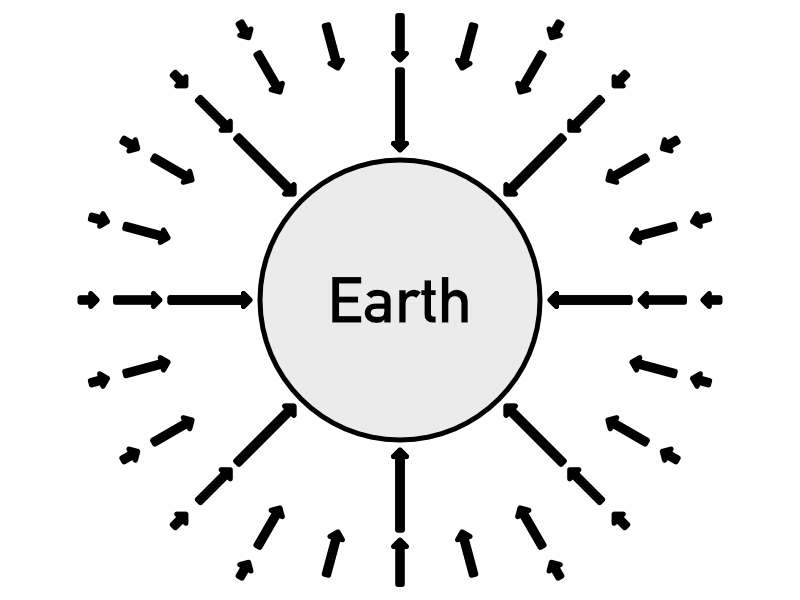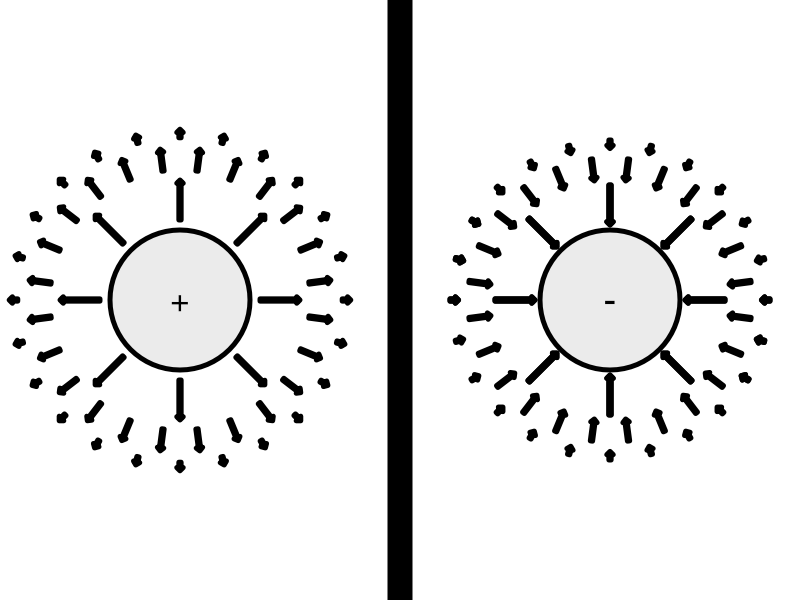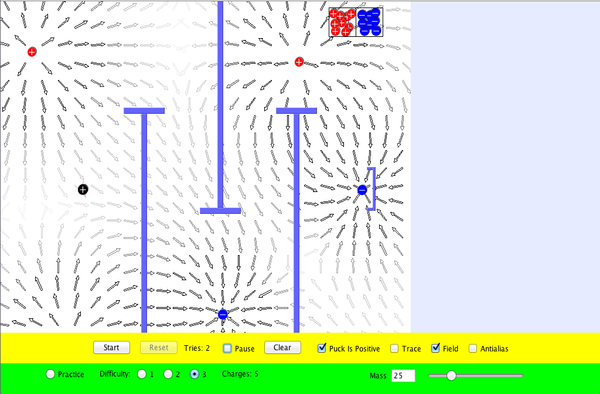Fields and Charge
There are mysterious and invisible forces everywhere in the world. Scientists realized this long, long before Star Wars existed, and rather than call these invisible forces The Force, the called them fields.
In your lab notebook: Come up with as many invisible forces as you can (at least 2)
Table of contents
Fields
Fields are invisible forces that work at a distance. Lets break that down:
- Invisible, meaning you can not see. Example, if you shove something, you can see that, hence it is not a field.
- Work at a distance, shoving something does not count because you have to be touching the thing you are moving. A field represents a force that acts everywhere!
Still confused? Here is what you should always think of when you hear the word field used in science, gravity. Yep, gravity, the field we all know and love. Let us check right quick if it fits our definition:
- Invisible? Can you see gravity? Nope. We are good for invisible.
- Works at a distance? Do you feel gravity when you are up in an airplane, or really anywhere near or around the earth? Yep. Good to go here too.
Now, the question is, if they are invisible, how do we draw them? Good question, give it a shot.
In your lab notebook: How would you draw a diagram of a field, and invisible force that acts over a distance?
Now for the answer. Arrows! See the image below. The size of the arrow shows the force, and the direction shows the force. Note, the farther you get from Earth, the less force you feel due to gravity, hence the arrows get smaller. Also, notice that the arrows always point towards Earth, that is another property of gravity, it pulls things together.

Charge
Qualitative Description
Charge is a single piece of electricity. We will cover where charge comes from next semester, but everyone knows what electricity is, even if they can’t explain it, so we are just going to leave it as charge is a single piece of electricity.
Why on earth talk about single pieces of electricity? Because it is much simpler than talking about lots of electricity.
Here is what you should know about charge:
- It comes in two types
- Positive (+)
- Negative (-)
You should know, the two types could have been called anything (Fred and Martha would have been good names).
From there, you just have to know how the two types of charge interact.
Gravity was easy to draw the field for because no matter what, things are always pulled together. Charge is a bit tricker since we have two different types. So, we must have a picture for both positive and negative charges. However, that is not enough because you also have to know what type of charge they are interacting with. It is assumed then that you are ALWAYS interacting with a positive charge, just so everyone knows.

Activity - Sticky tape lab
Short version of the video:
Longer one with more experiments:
Link to the Additional Questions
Quantitative Description
Pictures are well and good, but sometimes you just need a good old equation.
\[F_E = \frac{k_0 q_1 q_2}{r^2}\]- \(F_E\) is the electric force in Newtons
- \(k_0\) is a constant that is \(\approx 9E9 N m^2 / C^2\)
- \(q_1\) is one charge
- \(q_2\) is the other charge
- \(r\) is the distance between them.
An equation is all well and good, but that doesn’t really mean much. So, lets plug in some values, assuming that we have two groups of 1 billion positive charges (yes you really do need a billion charges grouped together to get decent numbers with this),
| Radius | Force (N) |
|---|---|
| 1 nm | 200 MN |
| 1 um | 200 N |
| 1 mm | 200 uN |
| 1 m | 0.2 nN |
Take a second to appreciate just how much of a change you get as you get farther and farther apart.
Activity - PhET Balloons
In your lab notebook, answer the following:
- Rub the balloon on the shirt. a. What overall charge does the balloon now have? b. What overall charge does the shirt now have?
- What happens when you drag the balloon away from the shirt and let it go? Why?
- Move the balloon over to the wall. a. What happens to the negative charges in the wall when you move the balloon near it? b. What happens to the positive charges in the wall when you move the balloon near it?
Activity - PhET John Travoltage
In your lab notebook, answer the following:
- What happens if you build up charge while his finger is on the door?
- What happens if you build up charge while his finger is away from the door?
- What happens to the electrons that are currently in the metal door knob? (Are they attracted or repelled?)
- Why are shocks worse when you touch conductors rather than insulators? __
Activity - PhET Hockey
The goal is to get the black positive charge (the puck) into the goal by adding + and - charges to the playing area. You should click the ‘field’ box to help you predict where the puck will go.
In your lab notebook record each solution you come up with showing the location of the starting positive charge, the location of all the charges you place, and the location of all the obstacles
Here is some warm-up activities.
- Put a single (+) and a single (-) charge on the screen. Sketch the resulting field into your lab notebook.
- Put two (+) charges on the screen. Sketch the resulting field into your lab notebook.
- And lastly, put a triangle of charges on the screen, two (+) and one (-). Sketch the resulting field into your lab notebook.
And lastly, play the game! But, since this is science class, sketch each solution you come up with into your lab notebook.
